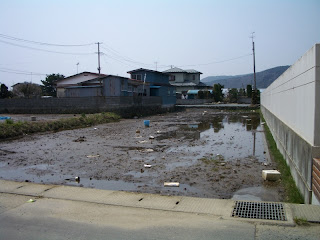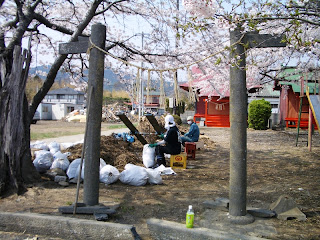Watanoha area is a district where I stayed for 2 nights and worked on the first day.
This area sank around 75cm because of the earthquake and rice fields around here are filled with sea water at high tide.
Sea water has started to fill this rice field.According to the local people, this area is much cleaner than before. But it will take a long time for the town to recover to the original state.
Rubbish was still scattered in all directions.
Rotten squids on a road. They have given off a terrible smell. I felt sick when I arrived in the town the day before. But on the second day I seemed to get used to it.
A destroyed concrete wall. At school we have earthquake disaster drills in Japan. I remember that we were told that if an earthquake happens, we shouldn't walk along the wall. I just saw the best example here.
Crushed cars bumped into a house. I wonder how the owners of these cars escaped on the 11th.
I heard from a local guy that when the Tsunami struck on the 11th, how to deal with one's car became the difference between life and death. Many people tried to escape from the Tsunami by their cars. It paralised the traffic. Some people abandoned their cars and ran towards mountains or high-up places and survived. On the contrary most of the people who had decided to stay in their cars lost their lives. One of his friends miraculously returned to life even if he was caught in the wave with his car. His car was lucky enough not to be hit by big floating objects. He waited for a while until his car came to the surface and broke the car window with his hammer and escaped. (Taking along a hammer is miraculous to me...) I think this is a really rare case.
According to a gardener who also worked as a volunteer, different to other trees, bamboo reacts immediately when they suck sea water. They change their colour into yellow.
Task of the day- cleaning a shrine
There are many rice fields around here, and the stalks from the fields were carried by the Tsunami and scattered all over this area. We need to take them away as soon as possible. There are a few reasons for this;
I worked with 3 team mates. We were asked to start cleaning a shrine with beautiful cherry blossom trees in full bloom. On our way to the shrine, I had seen many houses with mountains of straws. I asked why they wanted the shrine to be cleaned at first, rather than anybody's house.
According to a guy who worked with us, it's a shrine which worships a local God. The local people gather here from time to time for events or praying. They were supposed to hold a traditional cherry blossom festival, but they couldn't because of the disaster. They want to show their respect to God and hope that God protects them. They prioritise a shrine over their own property. That was a thought-provoking answer.
We put straws and twigs covered with mud into bags. Straws on top were dried and dried mud was blown up by wind. Inside was wet and heavier. I felt this was a never ending work... The amount of the straws in front didn't seem to get smaller. The photos below are one of the mountains we fought with. (Another mountain is on the other side of the shrine and not on these photos.)
Before and After
We put aside people's memorable objects when we found them. I really hope that they will be returned to the owners in the future.
When we worked, we received appreciative words from local people walking by. They must have indelible scars in their hearts. Just thinking about them, my heart ached. This work wouldn't delete their experience, but I want to support them as much as possible and help them get their normal life back as soon as possible.











No comments:
Post a Comment